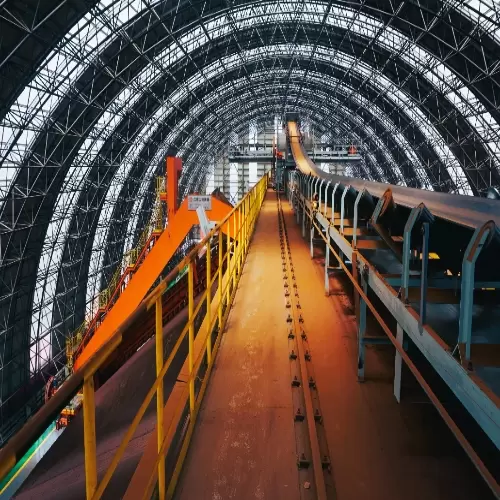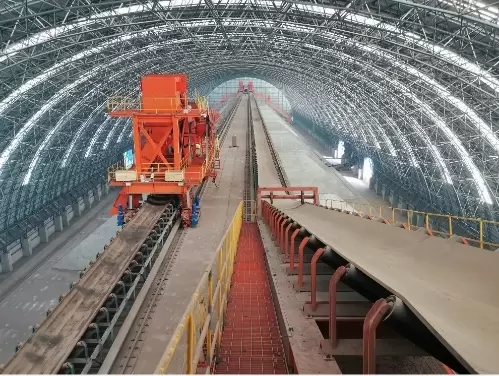Dump trucks are an essential part of the transportation industry and play a vital role in efficiently moving cargo from one place to another. This specialized frame provides a versatile solution for a variety of logistical needs, ensuring that cargo is delivered safely and on time. With their unique design and features, dump trucks increase productivity and streamline operations for businesses in different industries. Whether used in mining, construction, or agriculture, this equipment is a cost-effective and reliable way to transport materials. This article explores the features, benefits, and applications of dump trucks.
Understanding Tripper Conveyor Systems
Definition and Role
Tripper conveyor systems are crucial components in material handling, facilitating the efficient movement of materials along conveyor belts. These systems consist of a structure with wheels that travel along the conveyor belt, allowing for the precise discharge of materials at various points.
The primary function of tripper conveyor systems is to control the discharge of material at specified locations, offering flexibility in distribution. This mechanism enables industries to transport materials to different processing areas or storage locations seamlessly.
Material Distribution
Tripper systems operate by diverting materials off the main conveyor belt onto a spur line, ensuring accurate and controlled distribution. They are commonly used in industries such as mining, agriculture, and manufacturing to handle bulk materials efficiently.
By utilizing tripper conveyors, companies can distribute materials evenly across a designated area, preventing pileups and ensuring a smooth workflow. This process enhances productivity by reducing manual labor and streamlining material handling operations.
Operational Efficiency
The significance of tripper systems lies in their ability to optimize conveyor operations and enhance overall efficiency. These systems play a vital role in minimizing downtime, as they enable quick and precise material discharge without interrupting the main conveyor's operation.
Moreover, tripper conveyor systems contribute to cost savings by reducing material spillage and minimizing the need for additional equipment or manpower. Their implementation results in improved throughput rates and operational reliability, leading to enhanced productivity and profitability for businesses.
Types of Tripper Systems
Fixed vs. Mobile
Fixed tripper systems are stationary and installed at a specific location along the conveyor belt, while mobile trippers can move along the length of the conveyor. Mobile trippers offer flexibility in material discharge points, allowing for efficient distribution across different areas.
Gravity-fed vs. Powered
Gravity-fed tripper systems rely on the force of gravity to discharge materials, whereas powered tripper systems use motors or other sources of power. Powered trippers provide more control over material discharge, enabling precise distribution as per operational requirements.
Specific Uses in Industries
In mining operations, mobile trippers are commonly used to distribute bulk materials evenly along stockpiles for storage or transportation. Fixed tripper systems find applications in industries like agriculture, where they facilitate controlled discharge of grains into silos or processing units.

Key Features and Design
Essential Components
Tripper carriages consist of key components such as chutes and controls. The chute directs the material flow, while the controls manage the carriage's movement. These components work together to ensure efficient material handling.
Design Considerations
The robust construction of tripper carriages is crucial for their performance and reliability. Manufacturers prioritize using high-quality materials to enhance durability. The length of the carriage and its load capacity are carefully calculated to optimize functionality.
Durability and Maintenance
Durability is a key aspect of tripper system design. The robust design ensures longevity and minimizes downtime due to maintenance issues. Regular maintenance schedules are essential to keep the system running smoothly.
Benefits of Using Tripper Systems
Increased Material Handling Capacity
Tripper systems offer increased material handling capacity by efficiently distributing materials along a conveyor belt. This results in optimized operations, enabling industries to handle larger volumes of materials effectively.
Reduced Labor Costs and Improved Safety
One of the significant advantages of tripper systems is reduced labor costs due to automation. By minimizing manual intervention in material distribution, companies can streamline processes and allocate human resources more efficiently. improved safety is achieved as workers are exposed to fewer risks associated with manual handling.
Minimization of Material Waste
Tripper systems play a crucial role in minimizing material waste by ensuring precise and controlled material discharge. This precision prevents overloading or underutilization of materials, leading to cost savings and environmental benefits. Industries can enhance their sustainability efforts by reducing waste through the use of tripper systems.

Applications in Various Environments
Mining and Aggregate
Tripper carriages play a crucial role in the mining and aggregate industries by efficiently transporting materials within processing plants. They are essential for moving bulk materials such as coal, ore, and gravel along conveyor belts. This system enables precise discharge of materials at multiple points, enhancing operational efficiency.
In mining operations, tripper systems are utilized to distribute materials to different areas of the processing plant, ensuring a smooth workflow. These systems help in managing stockpiles and optimizing material handling processes. They significantly reduce manual labor requirements and enhance safety by minimizing the need for human intervention in material movement.
Manufacturing and Processing Plants
Manufacturing and processing plants benefit from the versatility of tripper systems in handling various materials efficiently. These systems are used to transport raw materials, semi-finished products, and finished goods within the production facility. They facilitate continuous material flow, contributing to streamlined operations and increased productivity.
Tripper carriages are designed to meet the specific needs of manufacturing plants, providing a flexible solution for material handling. They can be customized to accommodate different types of materials, sizes, and weights, making them ideal for diverse production environments. Their ability to automate material movement tasks reduces downtime and enhances overall operational efficiency.
Waste Management and Recycling
In waste management and recycling facilities, tripper systems are instrumental in sorting and transporting recyclable materials effectively. They enable the segregation of different types of waste for recycling purposes, contributing to sustainable waste management practices. These systems help in optimizing waste processing operations and maximizing resource recovery.
Tripper carriages support the recycling industry by facilitating the movement of materials such as plastics, paper, glass, and metals throughout the recycling process. They ensure efficient handling of recyclable materials from collection points to sorting facilities, enhancing the overall efficiency of recycling operations. Their role in automating material handling tasks minimizes manual labor requirements and reduces operational costs.
Customization Options for Efficiency
Customizable Design
Tripper carriages offer customizable design options to cater to various material handling needs. Companies can tailor the system to accommodate specific requirements, ensuring optimal performance.
Customization allows for the integration of advanced automation features, streamlining operations and reducing manual intervention. By incorporating automated controls, companies can improve efficiency and accuracy in material handling processes.
Enhanced Operational Efficiency
Tailored solutions play a crucial role in enhancing operational efficiency for tripper systems. Customizing the carriage enables companies to optimize material flow, leading to increased productivity and reduced downtime.
The ability to customize tripper carriages based on specific material handling needs ensures seamless integration with existing processes. This tailored approach results in improved workflow efficiency and overall operational performance.
Importance of Assessing Specific Needs
Before embarking on customization, it is vital for companies to assess their specific material handling needs. Understanding the nature of the materials being handled, volume requirements, and operational constraints is essential for designing an efficient system.

Technological Advances in Tripper Cars
Automation Systems
Tripper car technology has evolved significantly with the integration of automation systems. These systems enable precise control over the tripper's movements, enhancing operational efficiency. By automating functions such as positioning and discharge, operators can optimize material handling processes.
IoT Integration
The implementation of IoT technology in tripper car systems has revolutionized the industry. IoT sensors collect real-time data on various parameters such as belt speed, tonnage per hour (tph), and maintenance requirements. This data allows for proactive decision-making and predictive maintenance strategies.
Enhanced Efficiency
One of the key benefits of technological advancements in tripper cars is the enhanced efficiency they offer. By leveraging automation and IoT integration, operators can achieve higher throughput rates and improved accuracy in material discharge. This leads to reduced downtime and increased overall productivity.
Impact on Operations
The adoption of advanced control systems in tripper cars has had a profound impact on operational capabilities. Operators now have greater visibility and control over the entire material handling process, leading to smoother operations and reduced manual intervention. This results in cost savings and improved safety measures.
Improved Safety Measures
With the introduction of automation and IoT technologies, safety measures in tripper car operations have been significantly enhanced. Real-time monitoring of equipment conditions and predictive maintenance alerts help prevent breakdowns and accidents. This ensures a safer working environment for operators and maintenance personnel.
Enhancing Safety and Productivity
Safety Features
Tripper carriages are equipped with various safety features to ensure a secure working environment. Commonly integrated safety mechanisms include emergency stop buttons for immediate halting in case of any hazards. These systems often have automatic overload protection to prevent accidents due to excessive weight.
Workplace Safety Contribution
Tripper systems play a crucial role in enhancing overall workplace safety. By efficiently handling materials in demanding operations such as mining, these systems minimize the risks associated with manual material handling. The automation of tripper carriages reduces the need for human intervention in hazardous environments, thus significantly lowering the chances of accidents.
Productivity Improvement Strategies
Effective management of tripper systems can lead to substantial improvements in productivity. Regular maintenance schedules and reliability checks ensure that the equipment operates at optimal efficiency levels, minimizing downtime. Implementing energy-efficient practices in tripper system operations not only contributes to cost savings but also boosts productivity by ensuring a continuous workflow.
Closing Thoughts
The exploration of tripper conveyor systems has shed light on their diverse applications, customizable features, and the technological advancements enhancing their efficiency and safety. From mining to agricultural sectors, the versatility of tripper systems in handling bulk materials efficiently is evident. The benefits of increased productivity and minimized manual intervention make them indispensable in various industries. As technology continues to evolve, integrating smart solutions into tripper car designs will further optimize operations and ensure a safer working environment.
For those considering the implementation of tripper systems, evaluating specific needs and consulting with industry experts is crucial. The continuous improvements in design and functionality offer promising opportunities for enhancing material handling processes. Stay informed about the latest innovations to harness the full potential of tripper conveyor systems in your operations.
The Benefits of Tripper Carriage in Industrial Transportation
